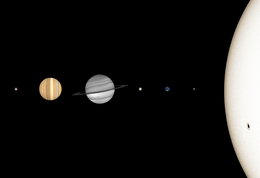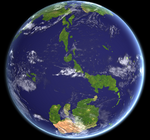Gentu System: Difference between revisions
Philimania (talk | contribs) No edit summary |
Philimania (talk | contribs) (→Planet) |
||
| (3 intermediate revisions by the same user not shown) | |||
| Line 52: | Line 52: | ||
==== Gentu ==== | ==== Gentu ==== | ||
{{main|Gentu}} | |||
' | [[File:Gentu.png|150px|thumb|Photogaphy of [[Gentu]] taken in 1999 from the [[Transnational Space Station]].]] | ||
[[Gentu]] (1 AU (150 million km; 93 million mi) from the [[Sun (Gentu)|Sun]]) is the largest of the inner planets, the only one known to have current geological activity, and the only place where life is known to naturally evolve. Its liquid hydrosphere is unique among the terrestrial planets, and it is the only planet where {{wp|plate tectonic}}s has been observed. Gentu's atmosphere is radically different from those of the other planets, having been altered by the presence of life to contain 21% free oxygen. The planetary magnetosphere shields the surface from solar and cosmic radiation, limiting atmospheric stripping and maintaining habitability. It has one natural satellite, [[Cynthia]] which has around 23 temporary inhabitants as of Enero of 1999. | |||
==== Isthylon ==== | ==== Isthylon ==== | ||
{{main|Isthylon}} | |||
[[File:Isthylon.png|150px|thumb|[[Isthylon]] in {{wp|true color}}.]] | |||
'' | [[Isthylon]] (2.1 AU (314.7 million km; 201 million mi) from the [[Sun (Gentu)|Sun]]) it is the 2nd largest and 1st densest of the inner planets, Isthylon has no natural satellites. The dominant geological features are impact craters or basins with ejecta blankets, lobed ridges or rupes that were probably produced by a period of contraction early in the planet's history, and volcanos such as [[Vounofalim]]. Isthylon's very tenuous atmosphere consists of solar-wind particles trapped by Isthylon's magnetic field, as well as atoms blasted off its surface by the solar wind. | ||
==== Inner belt ==== | ==== Inner belt ==== | ||
| Line 89: | Line 95: | ||
''TBA'' | ''TBA'' | ||
{{Template:GentuSystemInfo}} | |||
{{Template:GentuInfo}} | {{Template:GentuInfo}} | ||
[[Category:Gentu]] | [[Category:Gentu System]] | ||
Latest revision as of 13:25, 13 July 2022
This article is a work in progress. Any information here may not be final as changes are often made to make way for improvements or expansion of lore-wise information about Gentu. Please comment on this article's talk page to share your input, comments and questions. Note: To contribute to this article, contact User:Philimania. |
 | |
| Age | 4.931 billion years |
|---|---|
| Location | XXX |
| System mass | 1.0011 Solar masses |
| Nearest star | TBA |
| Nearest known planetary system | TBA |
| Planetary system | |
| Semi-major axis of outer known planet (Une'ara) | 35.30 AU |
| Distance to Kuiper cliff | 37 AU |
Populations | |
| Stars | 1 (Sun) |
| Known planets | |
| Known dwarf planets | TBA |
| Known natural satellites | 2,000+ |
| Known minor planets | TBA |
| Known comets | TBA |
| Identified rounded satellites | TBA |
| Orbit about Galactic Center | |
| Invariable-to-galactic plane inclination | 60.19° (ecliptic) |
| Distance to Galactic Center | 27,000 ± 1,000 ly |
| Orbital speed | 220 km/s; 136 mi/s |
| Orbital period | 225–250 myr |
| Star-related properties | |
| Spectral type | G2V |
| Frost line | ≈5 AU |
The Gentu System is the gravitationally bound system of the Sun and the objects that orbit it. The Gentu System formed 4.9 billion years ago from the gravitational collapse of a giant interstellar molecular cloud. The vast majority of the system's mass is in the Sun, with most of the remaining mass contained in the planet Trenas. The three inner system planets, Gumaya, Gentu, and Isthylon are terrestrial planets, being composed primarily of rock and metal. The two giant planets of the outer system, Enera and Trenas are substantially larger and more massive than the terrestrials. They are gas giants, being composed mainly of hydrogen and helium. The planet Une'ara is the outest planet of the Gentu System which, like the planets of the inner system, is composed primarily of rock and metal.
Formation
TBA
Sun
TBA
Planet
Inner Gentu System
Gumaya
TBA
Gentu
Gentu (1 AU (150 million km; 93 million mi) from the Sun) is the largest of the inner planets, the only one known to have current geological activity, and the only place where life is known to naturally evolve. Its liquid hydrosphere is unique among the terrestrial planets, and it is the only planet where plate tectonics has been observed. Gentu's atmosphere is radically different from those of the other planets, having been altered by the presence of life to contain 21% free oxygen. The planetary magnetosphere shields the surface from solar and cosmic radiation, limiting atmospheric stripping and maintaining habitability. It has one natural satellite, Cynthia which has around 23 temporary inhabitants as of Enero of 1999.
Isthylon
Isthylon (2.1 AU (314.7 million km; 201 million mi) from the Sun) it is the 2nd largest and 1st densest of the inner planets, Isthylon has no natural satellites. The dominant geological features are impact craters or basins with ejecta blankets, lobed ridges or rupes that were probably produced by a period of contraction early in the planet's history, and volcanos such as Vounofalim. Isthylon's very tenuous atmosphere consists of solar-wind particles trapped by Isthylon's magnetic field, as well as atoms blasted off its surface by the solar wind.
Inner belt
TBA
Outer Gentu System
Enera
TBA
Trenas
TBA
Une'ara
TBA
Outer belt
TBA
Comets
TBA
Human discovery & exploration
TBA



